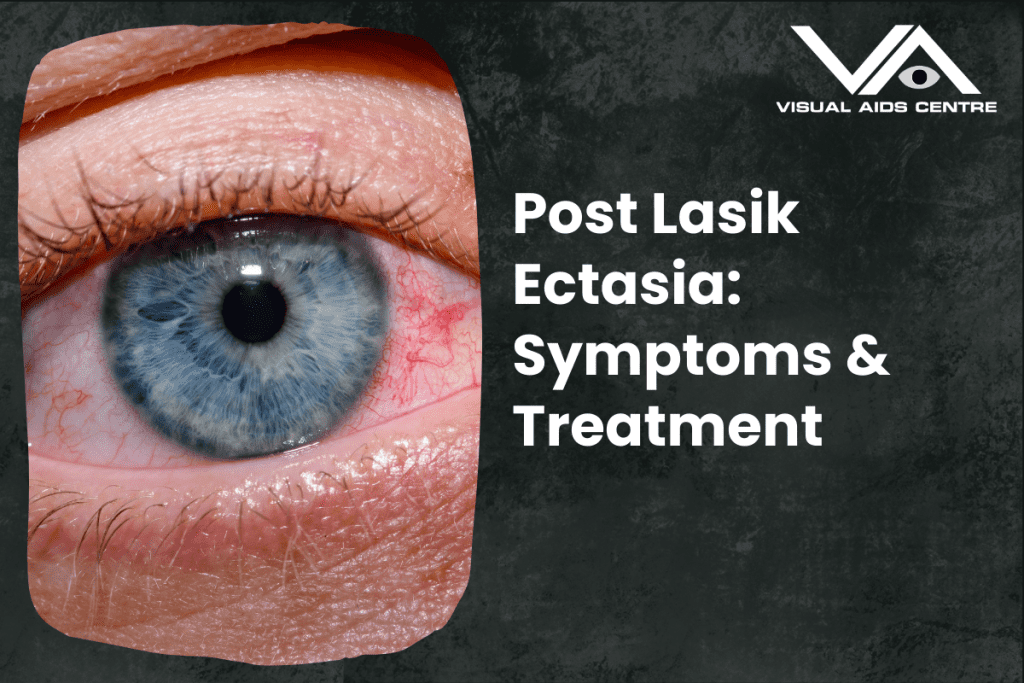Table of Contents
TogglePost LASIK ectasia is a rare but significant complication of laser eye surgery that can result in progressive corneal thinning and vision impairment.
Understanding its symptoms and treatment options is essential for timely diagnosis and effective management.

What is Post LASIK Ectasia?
Post LASIK ectasia, also referred to as post-LASIK corneal ectasia, is a condition characterised by the weakening and thinning of the cornea after undergoing LASIK surgery. This leads to an irregular corneal shape, which can cause the vision to deteriorate over time.
Although LASIK is generally a safe and effective procedure for correcting refractive errors like nearsightedness, farsightedness, and astigmatism, ectasia is a potential risk in certain cases, particularly where pre-existing corneal abnormalities are present.
Causes and Risk Factors
While the exact causes of post-LASIK ectasia are still being researched, some key factors can increase the likelihood of its occurrence, such as:
- Thinning of the cornea before surgery.
- High levels of refractive errors treated during LASIK.
- Pre-existing keratoconus or subclinical keratoconus, where the cornea is predisposed to thinning and deformation.
- Insufficient corneal tissue remaining post-surgery due to excessive tissue removal.
- Poor surgical technique or equipment errors.
Understanding these risk factors can guide both patients and ophthalmologists in deciding whether LASIK surgery is suitable or if alternative procedures like PRK (photorefractive keratectomy) may be a safer option.
Symptoms of Post LASIK Ectasia
The symptoms may not appear immediately after LASIK surgery but can develop gradually over months or even years. Early detection is essential for the prevention of additional complications.
Common Symptoms
1. Blurry or distorted vision
This is one of the most noticeable signs and often worsens over time as the cornea becomes increasingly irregular.
2. Progressive Myopia (Nearsightedness)
Patients may find that their vision appears clear for nearby objects but blurry for distant ones, even if the LASIK initially corrected their refractive error.
3. Irregular Astigmatism
Distorted vision could be due to irregular astigmatism caused by the uneven curvature of the cornea.
4. Halos and Ghosting
Some patients may experience halos around lights, especially when driving at night or looking at bright sources of light. Ghosting in one or both eyes is also a common complaint.
5. Frequent Changes in Vision Prescription
Individuals may need frequent adjustments to their glasses or contact lens prescriptions due to ongoing corneal changes.
6. Eye Sensitivity or Discomfort
Certain patients report increased light sensitivity or a sense of dryness in the eyes.
When to Consult an Eye Specialist?
If post-surgery vision seems irregular, fluctuating, or progressively deteriorating, it’s vital to consult an ophthalmologist as soon as possible. Early detection allows for more manageable treatment options.
Diagnosis of Post LASIK Ectasia
Accurate diagnosis of ectasia is essential for selecting the best course of treatment. This involves a combination of patient history, physical examination, and specialised imaging techniques.
Diagnostic Tests
1. Corneal Topography
This test provides detailed information about the cornea’s shape and thickness, helping to detect irregularities or thinning.
2. Pachymetry
This non-invasive procedure measures the thickness of the cornea to assess whether significant thinning has occurred.
3. Wavefront Aberrometry
This creates a 3D map of the eye, identifying visual abnormalities related to the cornea.
4. OCT (Optical Coherence Tomography)
OCT uses light waves to capture high-resolution cross-sectional images of the cornea, aiding in the confirmation of ectasia.
Importance of Early Diagnosis
Timely diagnosis is key to avoiding severe complications like extreme corneal thinning or the need for corneal transplants.
Treatment Options for Post LASIK Ectasia
The good news is that post-LASIK ectasia is treatable. Depending on the severity of the case and progression of symptoms, there are multiple treatment approaches available.
1. Corneal Collagen Cross-Linking (CXL)
CXL is considered one of the most effective treatments for halting the progression of ectasia.
- How it works: The procedure involves applying riboflavin (vitamin B2) drops to the cornea, followed by controlled ultraviolet (UV) light exposure. This strengthens the corneal fibres by creating new cross-links between the collagen molecules.
- Outcome: Patients often experience significant stabilisation and, in some cases, minor improvement in corneal shape and vision.
2. Specialised Contact Lenses
For those experiencing mild to moderate symptoms, customised lenses can offer significant relief. Popular options include:
- Rigid Gas Permeable (RGP) Lenses
These provide a smooth refractive surface over the irregular cornea.
- Scleral Lenses
These larger lenses cover the entire corneal surface, promoting stability and comfort.
- Hybrid Lenses
Hybrid lenses offer a combination of the comfort provided by soft lenses and the visual clarity associated with RGP lenses.
3. Intracorneal Ring Segments (ICRS)
ICRS are small, semi-circular devices implanted in the cornea to improve its shape and reduce irregular astigmatism.
- Effectiveness: They help stabilise the cornea’s structure but may not fully correct vision. Additional treatments like cross-linking may be required.
4. Topography-Guided Photorefractive Keratectomy (TG-PRK)
This advanced laser procedure reshapes the cornea to improve its symmetry and reduce astigmatism.
- Applications: TG-PRK is often combined with CXL for enhanced outcomes in mild to moderate ectasia cases.
5. Corneal Transplant (Keratoplasty)
For severe cases of ectasia where other treatments prove ineffective, a corneal transplant may be necessary.
- Types of Transplants:
- Partial-Thickness Transplant (Deep Anterior Lamellar Keratoplasty or DALK).
- Full-Thickness Transplant (Penetrating Keratoplasty or PK).
- Considerations: Recovery may take several months, and post-surgery management is crucial for success.
6. Vision Therapy
While not a cure, vision therapy (including exercises and tools) may help adapt to visual challenges and improve overall eye function.
Living with Post LASIK Ectasia
Post LASIK ectasia can be a challenging condition, but advances in medical technology and treatment options offer hope for stabilisation and improved vision.
Prevention Tips
1. Pre-Surgical Screening
Choose a reputable LASIK surgeon who conducts thorough pre-surgery corneal assessments to identify any potential risks.
2. Regular Check-Ups
Maintain a regular follow-up schedule to monitor your eye health post-surgery.
3. Avoid Excessive Eye Rubbing
Rubbing your eyes, both before and after surgery, can weaken the cornea and increase the risk of ectasia.
Importance of a Specialist
Always consult a qualified ophthalmologist or corneal specialist for diagnosis and care. Early interventions often lead to better outcomes.
Final Thoughts
Post LASIK ectasia, though rare, is a significant complication that requires prompt attention and management. Recognising its symptoms and understanding the treatment options can make all the difference in restoring functional vision and maintaining eye health.
If you or someone you know is experiencing vision changes after LASIK, don’t delay—schedule a consultation with an eye care professional immediately.
By staying informed and proactive, you can take the right steps to address this condition while safeguarding your visual well-being.













